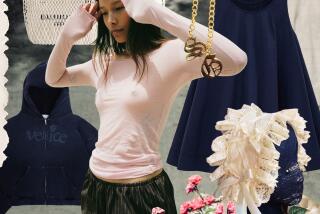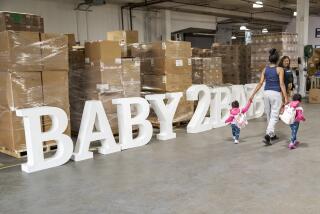Designer jeans, sleek strollers, exercise gyms: toddlers have a choice in a booming market : You’ve Come a Long Way, Baby
- Share via
Stockbroker John Kiggen pushed 18-month-old Brendan in his Aprica stroller into the Westside Pavilion Gymboree store and entertained the blond-haired baby by spinning little plastic wheels on the stroller’s front bar while his wife, Martha, shopped.
She walked past the tinted, transparent plastic screens, which stick to the inside of a car’s back windows with four suction cups and shield the eyes of a car seat-bound baby from the sun. She ignored the wide splash mats, for placement under high chairs to prevent spills, and the no-mess, soapy liquid-filled plastic figures with bubble-blowing rings that pop up at a squeeze.
Instead, she gave a few trial shakes to the traditional green baby rattles and rummaged among brightly colored jumpers and pullovers.
“Out of the millions and millions of things available for adults, multiply that by five or six times and that’s what you’ve got available for your children,” John Kiggen said.
Sales are booming for baby products ranging from cribs and bibs to $50 designer jeans and $2,000 high-fashion christening gowns. The range of products and companies in the industry is expanding as entrepreneurs and national retailers of traditionally adult products begin chasing the dollars of parents who are growing older and richer before they start having children. The number of babies born to U.S. women over age 29 climbed 81.2% from 1975 to 1985.
“There are a lot of people who have never been in the market before, (who are) coming into it because they see it as a very good opportunity,” said Judith Nolte, editor of American Baby magazine. The list of companies marketing to new parents no longer is limited to such nursery names as Gerber, but also includes the likes of Mobil Chemical, which now sells Hefty Tidies diaper disposal bags to hold soiled plastic diapers.
Although parents and grandparents may complain about the expense of it all, growing competition is also beginning to pinch profit margins and even force price discounts for less prestigious labels. Designer-brand infant clothes continue to sell well, however, despite doubts among many parents about whether the perceived extra quality justifies the additional cost.
“It gets pretty ridiculous, especially since they’re only going to drool over it, spill food on it, and the third time you wash it, it’s going to look the same shade of gray,” said Freddie McKenna, a West Los Angeles resident with a 2-year-old daughter, Alix.
Sales of infant furniture, bedding and accessories rose to $1.6 billion last year from $700 million in 1979, according to the Juvenile Products Manufacturers Assn. “We’re seeing companies that have been making wooden rocking chairs, and all of a sudden they’re making high chairs,” said William L. MacMillan, the association’s executive director. The organization’s membership has risen to 155 companies today from 71 in 1980, as new businesses have entered the field, he said.
Sales of accessories such as playpen and car seat covers have exploded into a $250-million market now from a base of less than $10 million in 1980, MacMillan said. Legislation and growing safety concerns among parents have pushed manufacturers’ sales of car seats to nearly 2 million units this year worth $75 million to $80 million from 1.2 million units and $30 million in 1980.
New products and services are flooding the market. Dy-Dee Diaper Service, a 450,000-per-week cloth diaper service headquartered in Pasadena, distributes to its customers a 209-name list of certified Lamaze teachers just in the Los Angeles area. Nappy Sacks, a 6-month-old partnership based in South Laguna, has taken on Mobil and now sells peach-colored deodorized plastic bags, which look like large sandwich bags, to hold disposable diapers.
Pawtucket, R.I.-based Hasbro, the nation’s largest toy maker, is launching Nursa, a disposable baby bottle system with pre-sterilized nipples and twist-on bags for milk. Baby exercise gyms are popping up across Southern California, offering exercise classes for babies as young as three months.
“It’s an opportunity for Mom to come with her newborn, to come and experience what it’s like with other moms with their newborns. It’s more of a social experience,” said Kevin J. Gray, director of My Gym in Van Nuys. “Children at that age (three months) rarely get to interact with other children at that age.”
The proliferation of stores marketing to infants and toddlers is apparent at the trendy Westside Pavilion shopping mall, where the third floor alone holds not only a Gymboree baby store but also Gap Kids, Bergstroms, Brooks Shoes for Kids, Mr. G’s for Kids and a Waldenkids bookstore with a tube through which small children can crawl into the store.
New parents are attracting corporate interest because they are older and have more to spend on fewer children. The annual total of live births in the United States has stagnated at about 3.7 million for the past five years and is expected to start dropping in the early 1990s. But the average age of U.S. mothers bearing their first child rose to 23.5 from 22.3 between 1975 and 1985, while the number of births to women over age 29 leaped to 940,186 from 518,856, according to the National Center for Health Statistics.
The number of first borns--for whom most cribs, strollers, car seats and other big-ticket baby products are purchased--has climbed as well, reaching 1.55 million in 1985. By contrast, in 1957, at the peak of the baby boom, first borns made up just 1.18 million of the 4.3 million babies born.
Spending on first-born babies typically is 25% greater than spending on subsequent babies, said Kenneth B. Greeman, a children’s products analyst for Fairchild Publications in New York. Sales of high-priced baby products have grown fastest. Five years ago, the typical baby gift bought at Saks Fifth Avenue cost between $25 and $50; now the range is $25 to $100, said Carla L. Slocum, vice president for children’s wear. “Adult fashions, trends and life styles are now very apparent for babies. . . . (Working mothers) have got more disposable income and they’ve got more guilt.”
Specialty stores selling expensive and fashionable baby products have also avoided the price wars and consequent lower profits that have begun to hurt mass merchandisers, said Robert R. Geisheker, Sears’ national retail marketing manager for infants and toddlers. Well more than half of the nation’s infant furniture is sold for less than full retail price, he said, adding that for the past two years, baby products have led in sales growth for most big retailers. “Because the industry has grown so much and there are so many more people involved . . . you can’t just go wild and raise your prices.”
But fashionable products continue to command prices that belie their diminutive sizes. On the second floor of Westside Pavilion, a 0-2-14 children’s apparel store sells $29 black denim Baby Guess miniskirts with matching $55 black denim jackets--all for 6-month-old baby girls.
Los Angeles-based Pour Le Bebe, which licenses the Guess name for use on young children’s clothing, has seen sales grow to between $1.6 million and $2 million a month since its founding three years ago, said Michel Benasra, the firm’s French designer, president and chief executive. Babies do appreciate fashionable clothing, he said. “More than you think, they care. They care, and the mother cares, and the grandmother cares.”
But many industry experts disagree. “An infant doesn’t really care whether it’s sleeping in a laundry basket or a dresser drawer or a fabulous, $2,000 Italian designer crib,” said Olivia I. Buehl, editor-in-chief of Baby magazine.
More to Read
Inside the business of entertainment
The Wide Shot brings you news, analysis and insights on everything from streaming wars to production — and what it all means for the future.
You may occasionally receive promotional content from the Los Angeles Times.










